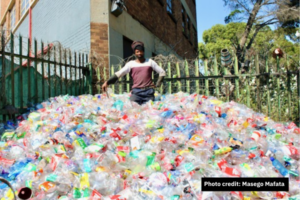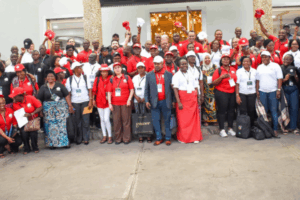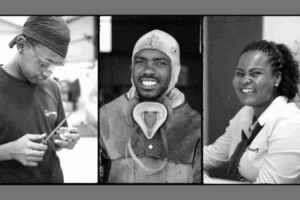Post-apartheid industrial policy has for the most part fallen short of delivering economic inclusion for women, particularly Black women. While there have been some improvements in women’s economic outcomes since 1994 – in part due to policies aimed at redressing broader structural inequality – South African industrial policy has primarily focused on “hard hats” industries built under apartheid. These industries – like gender – often offer workers comparatively good economic outcomes in terms of earnings and social protection, but they are dominated by men.
Over two-thirds of women are employed in community, social and personal services, wholesale and retail trade, and private households. In contrast, about 15% of men are employed in community, social and personal services, and almost two-thirds in manufacturing, construction, financial and other business services, and wholesale and retail trade. Men are also more likely to be in senior management roles (11%), while women are more likely (about a third) to be in elementary and domestic work occupations. In addition, men’s occupations show a bias towards “hard hats” roles as plant/machine operators and in craft and trade-related work (almost a third compared to 5% for women). In contrast, women are more likely (a fifth compared to just over 10% for men) to be in professional, technical and associate roles – which largely depend on knowledge and not “physical” labour. Similar trends can be seen in small business ownership, where men make up a higher share of formal business ownership than women.
However, women are not a homogenous group. In the same way that gender serves as an indicator for worse economic outcomes in the overall population, race predicts worse outcomes among women. Black women are less likely to be in employment and business ownership compared to women of other races. When they are economically active, it is more often in low-paying industries and occupations. Over a tenth of Black women are employed in private households (domestic workers). About a third are in community, social and personal services. In contrast, about 80% of employed White women are in financial and other business services, community, social and personal services, and wholesale and retail trade. These industries provide positions for two thirds of employed Coloured and Asian women.
Similar trends are seen in terms of women’s occupation. Black women are over-represented in elementary and domestic occupations and among clerical, service and sales workers (more than two thirds). Less than 5% of employed Black women are in senior management roles. In contrast, a fifth of employed White women are in senior management, as are about a tenth of Coloured and Asian women.
Lagging economic outcomes for women reflect broader failures in addressing the structural factors perpetuating economic exclusion, especially for Black women.
These problems are mainly historical. They are visible in unequal access to quality education, asset ownership and social networks, and spatial inequality. Black women are more likely for instance to have less than matric, and less likely to be employed even if they have a degree. Because of the privatisation of township housing, Black women are more likely than other women to own their homes, but their housing has a far lower value. Among White women who own property, about half are valued between R500 000 and R2 million, compared to about a tenth for Black women and almost a third for Coloured and Asian women.
In addition, South African industrial policy is entrenched in industries built under apartheid, which did not prioritise women’s economic inclusion. State support remains biased towards these industries, further entrenching socio-economic and spatial inequality. In 2018/19, for instance, the Department of Trade, Industry and Competition approved almost R3 billion in incentives for the automotive industry, in addition to large-scale support provided through tax incentives. Incentives for industrial infrastructure were also high, at R2 billion. In contrast, agro-processing and clothing, textiles, leather and footwear, both of which employ a higher share of women, received a combined R700 million in the same period. More than 90% of the 2018/19 incentives went to just four provinces (Gauteng, Western Cape, KwaZulu Natal and Eastern Cape).
Improving women’s participation in industrial policy, and the economy more broadly, requires more than lip service to empowerment.
For instance, while gender-mainstreaming programmes may increase the number of women promoted to senior roles, it does not address the structural factors keeping women, especially Black women, at the margins of industrial policy.
Better outcomes require:
a) Improved access to social infrastructure like quality education, health and family care, and stable and affordable energy to change how women use their time.
b) Addressing resource and spatial inequality by investing in townships and rural areas and, more broadly, in provinces with historical under-investment.
c) Collaborative action by the state and key stakeholders to set clear plans and actions for increasing women’s economic participation (using public/private employment programs for instance).
d) Investing in industries where women participate in large numbers, including industries that support industrial policy such as education.
Nokwanda Maseko is a Senior Economist at Trade and Industrial Policy Strategies (TIPS). Her work at TIPS is at the intersection of industrial policy, gender and the just transition.
RELATED ARTICLES
The Real Economy Bulletin | Q2 2024 – (A TIPS quarterly)
The invisible struggles of women leaders
Mainstreaming gender in free trade agreements







